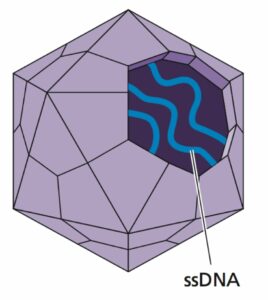Another excellent example of gain of function research is modification of a viral vector to make it more useful for human gene therapy.
Adenovirus associated virus (AAV) is the most commonly used vector for a variety of gene therapy applications, including gene replacement and gene editing. These small viruses, which comprise a single-stranded DNA genome surrounded by an icosahedral protein shell (illustrated), have a number of features that make them useful for gene therapy, including easy manipulation and growth in large quantities, and induction of persistent gene expression for long periods of time. An example is the drug Luxturna which is an AAV vector containing a retinal pigment gene that is used to treat some forms of blindness.
Naturally occurring AAV vectors have some limitations, including the propensity to become sequestered in the liver after systemic injection. Consequently reaching other organs with AAV vectors requires injection of large amounts of recombinant virus, which may be accompanied by toxicity.
A number of approaches have therefore been developed to modify AAV vectors so they preferentially infect other tissues. A number of muscle diseases would benefit from gene therapy and therefore AAV vectors have been developed to target that tissue. In one approach that I described before, ancestral AAV viruses were recovered and shown to efficiently infect muscle cell types.
A more recent approach involved modifying the AAV genome by inserting random stretches of 7 amino acids into the viral capsid protein, infecting mice with large libraries of these variants, and identifying those that best infect muscle. In addition, muscle-specific promoter sequences were also incorporated in the viral genome. After multiple rounds of infection of mice, recovery of viruses from muscle and reinfection, capsids were identified that more efficiently infect muscle tissue and less efficiently infect liver, in multiple mouse strains and in nonhuman primates. The new AAV capsids can rescue two different types of muscle disease in mice: Duchenne muscular dystrophy and X-linked myotubular myopathy after intramuscular inoculation.
The ability of these new AAV vectors to preferentially infect muscle cells depends on the presence of three added amino acids in the viral capsid, RGD. This three amino acid motif is known to bind cell surface proteins called integrins. Indeed, the increased efficiency of these engineered vectors depends on the presence of integrins on target cells.
These findings not only have produced better AAV vectors for targeting muscle tissue, but establish a strategy to engineer viruses to preferentially infect any tissue. The new vectors are the product of gain of function research: the original AAV has been given new properties. This work constitutes another example of the broad potential benefits of gain of function research in virology.


Why does there not seem to be cross-linking between microbe.tv and virology.ws? I keep looking for links to the blog articles from the various podcasts and YouTube streams, but the blog isn’t even mentioned in the ‘about’ of microbe.tv though I expected it to have a whole section from the hamburger menu.
Seems to me, some dynamic linking could boost viewing of both platforms. (I just wanted a quick reminder of what the TWiV logo virus is, but still haven’t found a note of it…)
The AAV’s are being given “new properties” because they are viruses that commonly infect and are mostly benign to humans with inefficient replication without helper virus in the natural state. But those used for gene therapy are RECOMBINANT AAVs. The recombinant AAVs are capable of delivering gene therapies, and they are made replication incompetent (by removing certain genes) so that replication in the dosed human is impossible. This makes human dosing more safe and not causing an actual infection. It also makes the research on these recombinant aav’s very safe.
Unlike the work in WIV which you are obviously attempting to defend with this rambling nonsense, these AAV and gene therapy researchers are NOT adding properties of added pathogenicity ***to viruses they consider to pose a clear and present danger of pandemic emergence*** (nor are they creating chimeric such viruses).
What a remarkable straw man argument you’ve put forth.
Honestly the amount of articles defending gain of function is becoming suspicious. First, what is described here is not the kind of gain of function research that people are worried about. No one is saying we shouldn’t use recombinant adenovirus to cure genetic diseases. That’s a stray man argument.
Why no reporting about the grant proposal of adding furin cleavage sites to bat coronavirusm? Obviously that’s of NO use in curing anything. I remember reporting about the dangers of making influenza virus more dangerous in gain of function research, on this blog. Why the same would not apply to bat coronavirus?